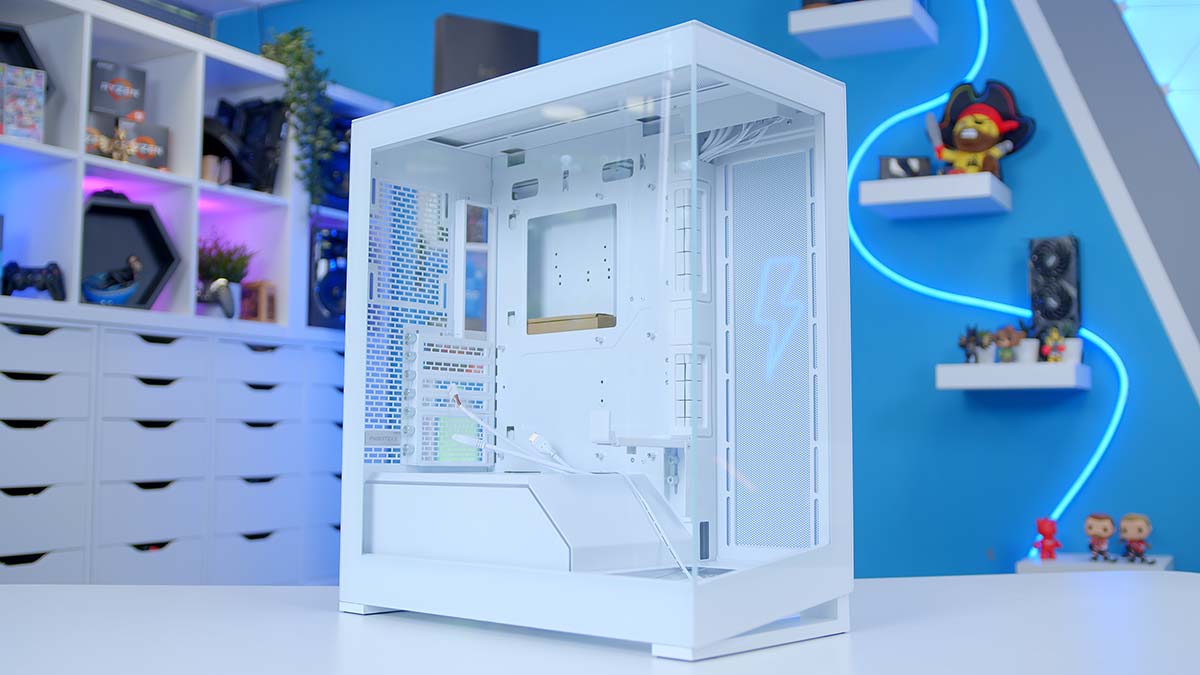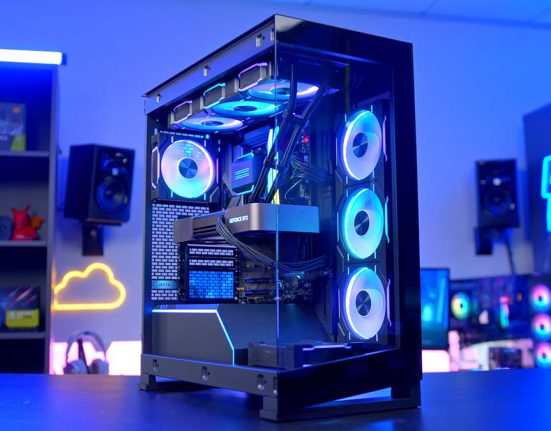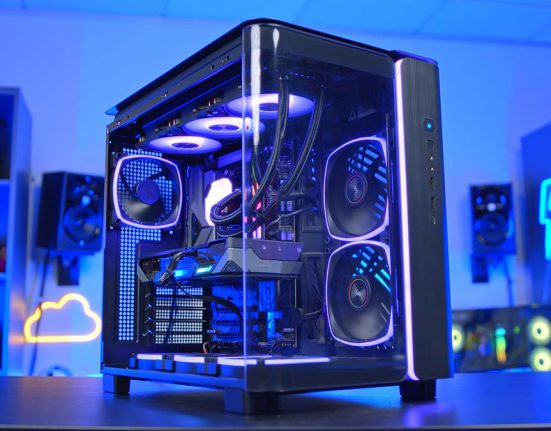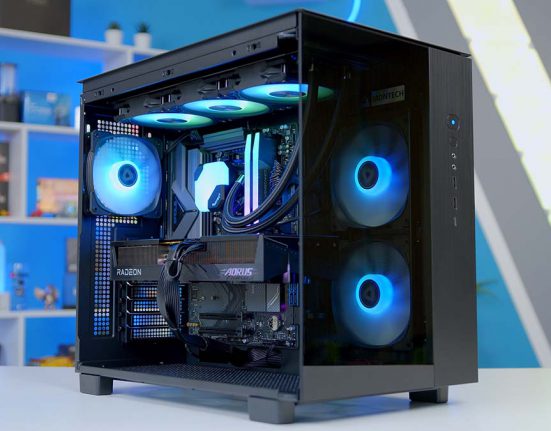The Phanteks NV5 is a seamless glass case that provides an unhindered view of all your components without compromising features or pricing. This chassis is highly affordable and offers a sub-$100 price point at the time of writing. However, it has robust features that make it a worthwhile pickup for novice builders or those looking to assemble a good-looking budget system. With so many fish-tank style chassis hitting the shelves in recent months, we’ve tested the Phanteks NV5 meticulously to see how it holds up compared to similarly priced options on the market.
The main benefit of seamless glass cases is that they offer a unique aesthetic compared to traditional ATX towers with only one side glass panel. However, one of the major drawbacks of these cases is that they tend to sacrifice features or airflow to compensate for the significant cost of the design change. Despite this, the Phanteks NV5 is one of the cheapest chassis to take this approach. For this reason, we’re curious to see if the competitive price is a hindrance or just another benefit of picking up this case.
In this review of the Phanteks NV5 case, we’ll examine the chassis’ specs, design, building quality, and features to see how it compares to existing options in this space.
Buy the Phanteks NV5 on:
Specification
The Phanteks NV5 chassis is a mid-tower case utilising the all-too-familiar dual glass panel design, providing an unobstructed window into your build. Fish-tank style cases have become all the rage within the past couple of years, with some manufacturers doing an excellent job with this design approach and others not so much. Despite the design, the Phanteks NV5 doesn’t support BTF motherboards. Instead, builders will be limited to traditional boards up to the E-ATX form factor. Fortunately, Phanteks has a ‘MK2’ version of the NV5, which supports reverse connector options.

It’s good to see support for all major desktop motherboards, as it provides greater configuration options. It’s worth noting that the NV5 only specifies that E-ATX boards up to 280mm are supported when the GPU support bracket isn’t being used, which should be kept in mind for those with large graphics cards. The NV5 has space for GPUs up to 440mm long and CPU air coolers up to 180mm tall. This is ample space for larger options, such as a DeepCool Assassin IV or Corsair A115.
| Specification | Phanteks NV5 |
|---|---|
| Form Factor | Mid-Tower |
| Motherboard Support | Mini-ITX, Micro-ATX, ATX, E-ATX |
| Case Dimensions (L x W x H) | 528mm x 239mm x 477mm |
| Front IO | 1 x USB 3.2 Gen2 Type-C 2 x USB 3.0 Type-A 1 x 3.5mm Combo Jack |
| PCI-E Slots | 7 + 3 (vertical) |
| Colour | Black White |
| Max Clearance | 180mm Cooler Height 440mm GPU Length 230mm PSU Length |
| Drive Support | Up to 4 x 2.5 inch Up to 3 x 3.5 inch |
| Fan Support | Top: 3 x 120mm Side: 3 x 120mm Rear: 1 x 120mm Bottom: 1 x 120mm |
| Radiator Support | Top: Up to 360mm Side: Up to 360mm Rear: Up to 120mm |
| Pre-Installed Fans | 0 |
| MSRP | $99.99 |
Fan support is slightly more restrictive due to the two glass panels. The NV5 can house eight fans in total, all of which are 120mm. There’s space for three at the top and side, while the rear and bottom panels are limited to one. The same goes for radiator mounting. The top and side panels are the main mounting points for AIO coolers, with space for 360mm radiators, but the rear and bottom panels can accommodate 120mm liquid coolers if needed.
The NV5 has decent storage space for SATA drives. While a case like the Corsair 3500X can only house two drives, the NV5 has space for four 2.5-inch or three 3.5-inch SATA storage drives. Front IO also offers a reasonable selection of ports: two USB 3.0 Type-A ports, a single USB 3.2 Gen2 Type-C port, and a 3.5mm combo jack for headphones and microphones.

Regarding the price, I’d say the $99.99 MSRP is a fair ask. Ultimately, seeing some pre-installed fans at this price point would be nice. While you can pick up a budget set of fans for around $20-$30, providing pre-installed fans saves builders time and money. The NV5 has plenty of space for various builds and aesthetics, so its near-$100 price point isn’t unreasonable.
Phanteks NV5 Design
Over the past couple of years, the number of fish tank cases on the market has multiplied. These chassis are called fish tanks simply because of their fundamental design philosophy, which is to provide an unhindered view of your components with two tempered glass panels. I have to admit, I’m pretty bored with this design. Every manufacturer has jumped on the bandwagon to create one of these cases, resulting in a somewhat oversaturated market of similarly looking options.
However, I feel Phanteks has made this design their own with the NV5. When switched on, the case has a small strip of RGB lighting on the power supply shroud, adding some nice lighting and colour.

Additionally, Phanteks has maintained a traditional Mid-Tower ATX design, so this case only has one chamber instead of the dual-chamber designs most of these cases tend to use. The lack of a secondary chamber means more space at the front of the case for bigger components, but this ultimately affects cable management.

The glass panels on the front and side are separated into two pieces instead of one seamless piece, making them easier to remove and reinstall during the building process. The Phanteks NV5’s metal frame feels robust and sturdy and can be picked up in white or black. We’ve got the white version, but the black NV5 offers a solid design for those with a darker-themed setup.

Airflow is a slight concern with the Phanteks NV5. While the top and rear panels are ventilated quite well, the side only offers a small set of perforations behind the fan mounting rails. The NV5 would be a more robust pickup if the opposing side panel were vented, allowing more hot air at the back of the case to escape.

The top and side panels feature fine metal mesh to prevent dust or potential blockages. While this metal mesh is appreciated, builders must clean out the case in the long term, as these vents will accumulate dust over time. This contrasts with the bottom panel, which uses a regular removable mesh tray.

At the rear of the case, things start to become a bit more compact. The PSU shroud doesn’t extend to the end of the case, which will make cable management a bit tighter. The same applies to SATA drives. While there’s a decent bit of room for the drives, getting them all plugged in once finished will likely be challenging.

Alternatively, the hard drive mounting panels can easily be removed from the case. These are attached to a hinged panel and can be removed simply if you don’t have any SATA drives.

Power supplies are mounted on the bottom of the case, just underneath the PSU shroud. The shroud is long and covers PSUs up to 230mm long, so there’s plenty of space for massive 1000W options. The front of the power supply shroud is removable, providing easier access to some cables. It also features a small flap to allow cables to thread through, which is a nice touch.

IO is at the top of the case, a fairly traditional location for the ports and power button. There are three USB ports alongside two buttons controlling the case’s RGB colour and modes. These are pretty handy, as they allow prospective buyers to easily switch between different lighting effects and colours without configuring software.

Building in the Phanteks NV5
While the Phanteks NV5’s design and specs look promising, there’s only one way to ascertain its quality: through a PC build. To do this, we paired the Phanteks NV5 with the Zotac Gaming Trinity White RTX 4070 Ti OC, Gigabyte B650 Elite AX ICE motherboard, and AMD Ryzen 7 7800X3D to build an excellent gaming PC, showcasing the strengths and weaknesses of this chassis.
Internal Space
Internal space is an evident strength of the NV5. Its compact nature makes it incredibly easy to carry around and is aimed at those seeking a high-quality but smaller case. Despite being designed to be slightly more compact, the NV5 can accommodate large builds with 360mm radiators, many fans, and large graphics cards.

Unfortunately, the PSU shroud doesn’t have space for fans, which will limit airflow, but the case is very open and has plenty of ventilation to help with thermals. Getting a motherboard installed was incredibly simple. We opted for the Gigabyte B650 AORUS Elite AX ICE, an ATX board. The NV5 is pre-configured out of the box for ATX PCBs, so there is no reason to shift any standoffs.

Installing a graphics card was straightforward as well. The Zotac 4070 Ti SUPER slipped into the build with no issues, and there was plenty of clearance at the end of the GPU (about 130mm of space) to move your hands around easily enough. Relocating the GPU bracket is very simple. Two screws need to be loosened, and the bracket can be adjusted up or down to match the height of your card.
Radiator and Fan Mounting
Because the Phanteks NV5 doesn’t come with any pre-installed fans, we had to supply our own. In this configuration, the Phanteks D30 fans were responsible for airflow. We decided to mount three on the side panel and one on the bottom, acting as intake. The top and rear fans are being used to exhaust air instead.

Getting everything appropriately installed was simple. Removing the top panel provides access to the mounting rails for fans or an AIO; the same applies to the side panel. The side panel is also recessed, so there are no concerns about the fans causing clearance problems.
The bottom fan can be added to the case by removing the bracket. After loosening the screw closest to the side panel, the bracket lifts up and out, and then a fan can be attached.

Overall, mounting the cooling hardware with the Phanteks NV5 was pretty simple. There aren’t many quality-of-life features, but the vast majority of the case parts don’t require tools, apart from the one odd screw here and there.
Ease of Building
Regarding ease of use, the Phanteks NV5 is constructed very well and offers a hassle-free experience for those building with it. It isn’t particularly fancy on the features front. There isn’t anything mindblowing from a design perspective, but this chassis thrives in its simplicity. Thanks to the amount of clearance, getting everything into the case was quick and simple.
The back of the case isn’t as spacious as the front, so builders need to be careful with cable management to minimise any bulge. However, there are plenty of Velcro ties to hold all of the wire mess in place. These ties are surprisingly resilient and have a significant amount of elasticity.

The screw organiser in the accessory box is a nice touch. First-time builders or those who haven’t upgraded in some time can easily pick out the correct screws needed for the motherboard and power supply. Building in this chassis was a breeze, and we were able to put together a gorgeous-looking system. I’m sure frequent YouTube channel viewers will likely see more of this case in new builds, so watch this space!
Features We Like
Removable PSU Shroud
In this case, the Phanteks NV5’s PSU shroud sticks out and somewhat detracts from the overall design. However, it isn’t without any functionality. The front of the shroud can be removed to reveal your build’s power cables.

Removing power cables when they’ve been installed can be difficult because there’s often limited space in the PSU chamber to access them. With this removable shroud, however, removing or installing cables is incredibly simple, making upgrading or troubleshooting very straightforward.
Integrated GPU Bracket
This case also comes with an integrated GPU bracket. With graphics cards progressively getting bigger over the years, these brackets are a solid value add, as they can alleviate sag, which reduces the risk of your card being damaged over time.

Streamlined Front Panel Cables
More manufacturers have streamlined front panel cables, turning JFP1 into a dedicated header. Fortunately, Phanteks is one of these manufacturers. The NV5 features a set of white wires and an entire connector for JFP1 power, making the building process more manageable.

Features We Don’t Like
No Pre-Installed Fans
Unfortunately, one of this case’s most significant drawbacks is its lack of pre-installed fans. I feel the build quality and affordable price point excuse this to a degree, but a good set of fans isn’t inexpensive. Most builders are looking at spending $40-$50 for a solid pack of fans, and at this point, it might make more sense to buy a pricier case that comes with fans, with the Montech King 95 Pro being a prime example.

Conclusion
Phanteks NV5

Product Name: NV5
Brand: Phanteks
-
Features
-
Design
-
Versatility
-
Value For Money
Summary
The Phanteks NV5 case is a highly affordable chassis that offers excellent value to those on a budget and first-time builders. The main focuses of the NV5 are build quality and aesthetics. This case is straightforward to build in and offers considerable clearance for a massive range of components, allowing builders to assemble a bespoke system. Most of the case is tool-less, cable management is made simple due to the Velcro ties and mass of cutouts, and JFP1 power is streamlined into an individual header alongside the other cables, which all match the colour of the case. Overall, there’s enormous value here for those just looking for a case that’s easy to use and can start building immediately.
The only major caveat to consider here is the lack of fans, which will be a point of contention for some. Having a set of pre-installed fans would only increase the value of this case, so it’s a shame Phanteks hasn’t capitalised on this. Despite this, not having any fans isn’t a deal-breaker for us. Picking up a solid set of fans can become somewhat expensive, but those budgeting will be able to find a decent pack for relatively cheap, keeping build costs low regardless. I’d argue that if you’re looking for an affordable, well-built case, the Phanteks NV5 is worth picking up.
Pros
✅ Excellent build quality
✅ Integrated GPU support bracket
✅ Looks gorgeous
Cons
❌ No pre-installed fans
❌ Lacks a GPU riser
❌ No 140mm support




![FI_ [DP040] main image](https://geekawhat.com/wp-content/uploads/2025/08/FI_-DP040-Gallery-2-551x431.jpg)


